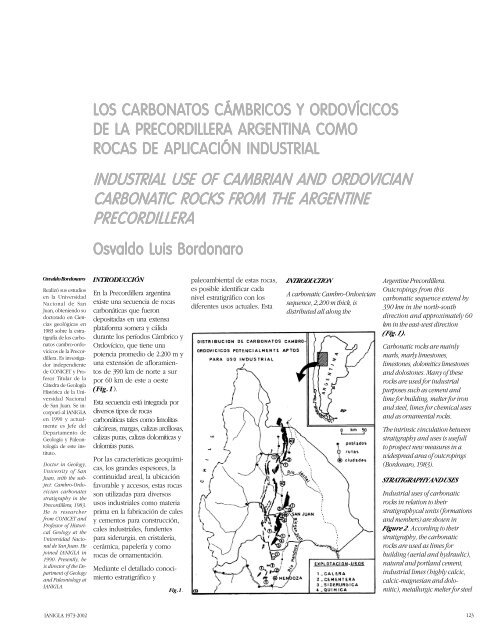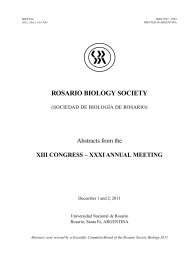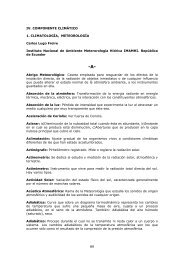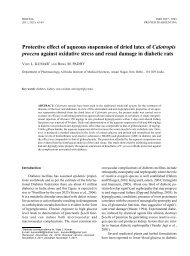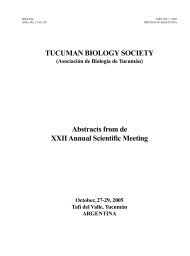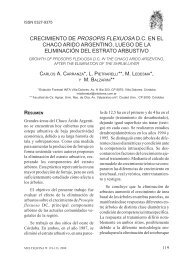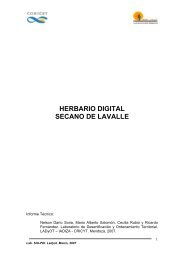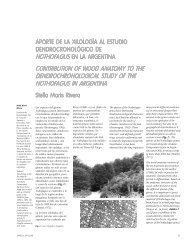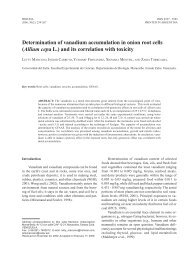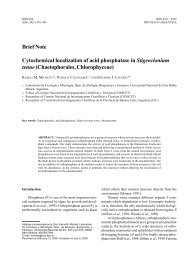Los carbonatos cámbricos y ordovícicos de la Precordillera ...
Los carbonatos cámbricos y ordovícicos de la Precordillera ...
Los carbonatos cámbricos y ordovícicos de la Precordillera ...
Create successful ePaper yourself
Turn your PDF publications into a flip-book with our unique Google optimized e-Paper software.
LOS LOS CARBONA CARBONATOS CARBONA TOS C CCÁMBRICOS<br />
C MBRICOS Y Y ORDOV ORDOVÍCICOS<br />
ORDOV CICOS<br />
DE DE LA LA PRECORDILLERA PRECORDILLERA ARGENTINA ARGENTINA COMO<br />
COMO<br />
ROCAS ROCAS DE DE APLICACI APLICACIÓN APLICACI N INDUSTRIAL<br />
INDUSTRIAL<br />
INDUSTRIAL INDUSTRIAL USE USE OF OF CAMBRIAN CAMBRIAN AND AND ORDOVICIAN<br />
ORDOVICIAN<br />
CARBONA CARBONATIC CARBONA TIC ROCKS ROCKS FROM FROM THE THE ARGENTINE<br />
ARGENTINE<br />
PRECORDILLERA<br />
PRECORDILLERA<br />
Osvaldo Osvaldo Luis Luis Bordonaro<br />
Bordonaro<br />
Osvaldo Bordonaro INTRODUCCIÓN<br />
Realizó sus estudios<br />
en <strong>la</strong> Universidad<br />
Nacional <strong>de</strong> San<br />
Juan, obteniendo su<br />
En <strong>la</strong> <strong>Precordillera</strong> argentina<br />
existe una secuencia <strong>de</strong> rocas<br />
carbonáticas que fueron<br />
doctorado en Ciencias<br />
geológicas en<br />
1983 sobre <strong>la</strong> estratigrafía<br />
<strong>de</strong> los carbo-<br />
<strong>de</strong>positadas en una extensa<br />
p<strong>la</strong>taforma somera y cálida<br />
durante los períodos Cámbrico y<br />
natoscambro-<strong>ordovícicos</strong> <strong>de</strong> <strong>la</strong> <strong>Precordillera</strong>.<br />
Es investigador<br />
in<strong>de</strong>pendiente<br />
<strong>de</strong> CONICET y Pro-<br />
Ordovícico, que tiene una<br />
potencia promedio <strong>de</strong> 2.200 m y<br />
una extensión <strong>de</strong> afloramientos<br />
<strong>de</strong> 390 km <strong>de</strong> norte a sur<br />
fesor Titu<strong>la</strong>r <strong>de</strong> <strong>la</strong><br />
Cátedra <strong>de</strong> Geología<br />
Histórica <strong>de</strong> <strong>la</strong> Uni-<br />
por 60 km <strong>de</strong> este a oeste<br />
(Fig. 1).<br />
versidad Nacional<br />
<strong>de</strong> San Juan. Se incorporó<br />
al IANIGLA<br />
Esta secuencia está integrada por<br />
diversos tipos <strong>de</strong> rocas<br />
en 1990 y actual- carbonáticas tales como limolitas<br />
mente es Jefe <strong>de</strong>l<br />
Departamento <strong>de</strong><br />
Geología y Paleontología<br />
<strong>de</strong> este ins-<br />
calcáreas, margas, calizas arcillosas,<br />
calizas puras, calizas dolomíticas y<br />
dolomías puras.<br />
tituto.<br />
Doctor in Geology,<br />
University of San<br />
Juan, with the sub-<br />
Por <strong>la</strong>s características geoquímicas,<br />
los gran<strong>de</strong>s espesores, <strong>la</strong><br />
continuidad areal, <strong>la</strong> ubicación<br />
ject:Cambro-Ordo- favorable y accesos, estas rocas<br />
vician carbonates<br />
stratigraphy in the<br />
<strong>Precordillera</strong>, 1983.<br />
He is researcher<br />
son utilizadas para diversos<br />
usos industriales como materia<br />
prima en <strong>la</strong> fabricación <strong>de</strong> cales<br />
from CONICET and<br />
Professor of Historical<br />
Geology at the<br />
Universidad Nacio-<br />
y cementos para construcción,<br />
cales industriales, fun<strong>de</strong>ntes<br />
para si<strong>de</strong>rurgia, en cristalería,<br />
nal <strong>de</strong> San Juan. He cerámica, papelería y como<br />
joined IANIGLA in<br />
1990. Presently, he<br />
rocas <strong>de</strong> ornamentación.<br />
is director of the Department<br />
of Geology<br />
and Paleontology at<br />
Mediante el <strong>de</strong>tal<strong>la</strong>do conocimiento<br />
estratigráfico y<br />
IANIGLA.<br />
Fig. 1.<br />
paleoambiental <strong>de</strong> estas rocas,<br />
es posible i<strong>de</strong>ntificar cada<br />
nivel estratigráfico con los<br />
diferentes usos actuales. Esta<br />
INTRODUCTION<br />
A carbonatic Cambro-Ordovician<br />
sequence, 2,200 m thick, is<br />
distributed all along the<br />
Argentine <strong>Precordillera</strong>.<br />
Outcropings from this<br />
carbonatic sequence extend by<br />
390 km in the north-south<br />
direction and approximately 60<br />
km in the east-west direction<br />
(Fig. 1).<br />
Carbonatic rocks are mainly<br />
marls, marly limestones,<br />
limestones, dolomitics limestones<br />
and dolostones. Many of these<br />
rocks are used for industrial<br />
purposes such as cement and<br />
lime for building, melter for iron<br />
and steel, limes for chemical uses<br />
and as ornamental rocks.<br />
The intrinsic vincu<strong>la</strong>tion between<br />
stratigraphy and uses is usefull<br />
to prospect new measures in a<br />
wi<strong>de</strong>spread area of outcropings<br />
(Bordonaro, 1983).<br />
STRATIGRAPHY AND USES<br />
Industrial uses of carbonatic<br />
rocks in re<strong>la</strong>tion to their<br />
stratigraphycal units (formations<br />
and members) are shown in<br />
Figure 2. According to their<br />
stratigraphy, the carbonatic<br />
rocks are used as limes for<br />
building (aerial and hydraulic),<br />
natural and port<strong>la</strong>nd cement,<br />
industrial limes (highly calcic,<br />
calcic-magnesian and dolomitic),<br />
metallurgic melter for steel<br />
IANIGLA 1973-2002 123
e<strong>la</strong>ción intrínseca que vincu<strong>la</strong> <strong>la</strong><br />
estratigrafía con <strong>la</strong> utilidad constituye<br />
un método práctico y expeditivo <strong>de</strong><br />
prospección <strong>de</strong> nuevos niveles <strong>de</strong><br />
utilidad económica en nuevas áreas<br />
don<strong>de</strong> afloran estas rocas<br />
(Bordonaro, 1983).<br />
ESTRATIGRAFÍA Y USOS<br />
En el cuadro <strong>de</strong> <strong>la</strong> Figura 2 se<br />
han colocado, en forma<br />
parale<strong>la</strong> a <strong>la</strong> columna<br />
estratigráfica, <strong>la</strong>s aplicaciones<br />
industriales tanto actuales como<br />
potenciales <strong>de</strong> <strong>la</strong>s rocas carbonáticas,<br />
i<strong>de</strong>ntificadas con cada unidad<br />
estratigráfica. El<strong>la</strong>s son usadas en <strong>la</strong><br />
fabricación <strong>de</strong> cales para <strong>la</strong><br />
construcción (hidráulicas y aéreas),<br />
cementos Port<strong>la</strong>nd y natural, cales<br />
industriales (áltamente cálcicas,<br />
cálcicas-magnesianas, y dolomíticas),<br />
fun<strong>de</strong>ntes para <strong>la</strong> e<strong>la</strong>boración <strong>de</strong><br />
arrabios y aceros, en <strong>la</strong> industria<br />
química para <strong>la</strong> obtención <strong>de</strong> óxido<br />
<strong>de</strong> calcio, carburo <strong>de</strong> calcio, óxido <strong>de</strong><br />
magnesio y magnesio metálico.<br />
Se han graficado <strong>la</strong>s leyes promedios<br />
<strong>de</strong> CO Ca y CO Mg en forma <strong>de</strong><br />
3 3<br />
curva porcentual obtenidas <strong>de</strong> unos<br />
1000 análisis químicos distribuidos<br />
en toda <strong>la</strong> columna estratigráfica.<br />
También se grafica el porcentaje <strong>de</strong><br />
residuo insoluble obtenido <strong>de</strong> los<br />
análisis químicos y el contenido <strong>de</strong><br />
sílice libre en forma <strong>de</strong> chert o<br />
pe<strong>de</strong>rnal, dado en forma estimativa.<br />
(Fig. 2). Todos estos valores<br />
reflejan en forma gráfica <strong>la</strong> calidad y<br />
variedad <strong>de</strong>l material analizado.<br />
Formación La Laja (Cámbrico<br />
inferior - Cámbrico medio)<br />
Está integrada por diferentes tipos<br />
<strong>de</strong> calizas, calizas arcillosas, margas y<br />
limolitas, con estratificación fina,<br />
<strong>la</strong>josas y con colores pardos,<br />
amarillos y grises. Toda <strong>la</strong> formación<br />
está subdividida en 4 miembros<br />
(Bordonaro,1980). El Miembro<br />
Rivadavia posee leyes <strong>de</strong> CO Ca 3<br />
superior al 80 %, el contenido <strong>de</strong><br />
CO Mg es inferior al 5% y no tiene<br />
3<br />
Silice libre. <strong>Los</strong> Miembros Soldano y<br />
Juan Pobre contienen abundante<br />
residuo insoluble con Oxidos <strong>de</strong><br />
Hierro, Alúmina y silicatos.<br />
Explotando estos tres miembros en<br />
forma conjunta se obtiene el Ca y<br />
aditivos necesarios para <strong>la</strong><br />
e<strong>la</strong>boración <strong>de</strong>l Clinker <strong>de</strong>l cemento<br />
Port<strong>la</strong>nd y natural. Estos mismos<br />
niveles son útiles para e<strong>la</strong>borar cales<br />
hidráulicas. El Miembro Rivadavia<br />
tambien es apto para fabricar cales<br />
aéreas por su alto contenido <strong>de</strong> OCa<br />
y escaso residuo insoluble.<br />
Formación Zonda<br />
(Cámbrico superior)<br />
and iron, chemical industry of<br />
OCa, calcic carbi<strong>de</strong>, OMg and<br />
metallic magnesium.<br />
More than a thousand chemical<br />
analyses were carried out to<br />
evaluate the CO Ca and CO Mg<br />
3 3<br />
frecuency curves for the different<br />
stratigraphic levels. The<br />
unsoluble residues and the free<br />
silica presents as chert were also<br />
evaluated (Fig. 2). These<br />
chemical analyses provi<strong>de</strong>d the<br />
bases to asses tha quality and<br />
variety of the carbonatic<br />
materials.<br />
La Laja Formation (Lower to<br />
Middle Cambrian)<br />
This unit is composed by finely<br />
stratified limestones, marls and<br />
limolites, varing in color from<br />
gray and brown to yellow. This<br />
formation comprises four<br />
members (Bordonaro,1980) . The<br />
124 Geología Regional - Regional Geology
Está integrada por dolomías y<br />
dolomías cálcicas con<br />
estratificación <strong>la</strong>minada, gruesa<br />
y maciza, con colores grises c<strong>la</strong>ros,<br />
oscuros y b<strong>la</strong>nquecinos. Está dividida<br />
en cuatro miembros con notables<br />
diferencias geoquímicas y litológicas.<br />
El miembro inferior posee dolomías<br />
micríticas y <strong>la</strong>minadas con<br />
porcentajes <strong>de</strong> hasta 44% <strong>de</strong><br />
CO Mg, con residuo insoluble <strong>de</strong><br />
3<br />
hasta 2%, bajo contenido <strong>de</strong> Fe, P y<br />
S. Sobreyace un miembro <strong>de</strong><br />
dolomías macizas microesparíticas a<br />
esparíticas, con colores grises c<strong>la</strong>ros.<br />
Contiene niveles con 44 % <strong>de</strong><br />
CO Mg, residuo insoluble menor al 1<br />
3<br />
% y sin pe<strong>de</strong>rnal ni otras impurezas.<br />
Ambos mienbros son utilizados en <strong>la</strong><br />
e<strong>la</strong>boración <strong>de</strong> cales dolomíticas y<br />
magnesianas usadas como fun<strong>de</strong>ntes<br />
para e<strong>la</strong>borar arrabio. <strong>Los</strong> elevados<br />
tenores <strong>de</strong> magnesio y ausencia <strong>de</strong><br />
impurezas <strong>la</strong>s hace potencialmente<br />
aptas para <strong>la</strong> obtención <strong>de</strong> magnesia<br />
cáustica (Bordonaro y Arroqui, 1995).<br />
<strong>Los</strong> dos miembros superiores poseen<br />
menores tenores <strong>de</strong> magnesio (hasta<br />
40 % <strong>de</strong> CO Mg) y mayores<br />
3<br />
impurezas <strong>de</strong> pe<strong>de</strong>rnal. Sólo el<br />
miembro superior pue<strong>de</strong> ser útil para<br />
e<strong>la</strong>borar cales magnesianas.<br />
Formación La Flecha<br />
(Cámbrico superior)<br />
Está <strong>de</strong>finida por una alternancia<br />
cíclica <strong>de</strong> calizas y dolomías con<br />
abundante pa<strong>de</strong>rnal y estructuras<br />
algales (Baldis et al., 1981). Esta<br />
constante alternancia en bancos <strong>de</strong><br />
pocos metros <strong>de</strong> espesor hace<br />
imposible <strong>la</strong> explotación individual <strong>de</strong><br />
cada banco. Actualmente sólo se<br />
utilizan algunos paquetes dolomíticos<br />
<strong>de</strong> mayor potencia (hasta 25 m) con<br />
leyes que no superan el 40 % <strong>de</strong><br />
CO Mg, hasta un 3 % <strong>de</strong> residuo<br />
3<br />
insoluble, pero frecuentemente<br />
están contaminadas con pe<strong>de</strong>rnal.<br />
Estos se <strong>de</strong>stinan a <strong>la</strong> e<strong>la</strong>boración <strong>de</strong><br />
cales magnesianas o en cristalería.<br />
<strong>Los</strong> niveles calizos interca<strong>la</strong>dos son<br />
<strong>de</strong> baja ley y ma<strong>la</strong> calidad por el<br />
elevado contenido <strong>de</strong> magnesio y<br />
abundancia <strong>de</strong> pe<strong>de</strong>rnal.<br />
Formación La Sil<strong>la</strong><br />
(Ordovícico inferior)<br />
Esta formación <strong>de</strong> unos 200 m <strong>de</strong><br />
potencia se caracteriza por tener<br />
calizas macizas micríticas (Keller et al.,<br />
1994) con el mayor contenido <strong>de</strong><br />
calcio <strong>de</strong> toda <strong>la</strong> secuencia,<br />
alcanzando valores <strong>de</strong>l 99 % <strong>de</strong> CO3 Ca. A<strong>de</strong>más tienen muy poco OMg,<br />
residuo insoluble menor al 1 %,<br />
ausencia <strong>de</strong> sílice libre y valores <strong>de</strong> S<br />
y P inferiores al 0,03 y 0,01 %<br />
respectivamente. estas cualida<strong>de</strong>s le<br />
otorgan excelente calidad como<br />
materia prima para e<strong>la</strong>borar cales<br />
altamente cálcicas usadas en <strong>la</strong><br />
industria si<strong>de</strong>rúrgica, cales y<br />
cementos para <strong>la</strong> construcción,<br />
Oca y carburo <strong>de</strong> Ca para <strong>la</strong><br />
industria química.<br />
Formación San Juan<br />
(Ordovícico inferior)<br />
Contiene calizas <strong>la</strong>josas,<br />
arcillosas y margas con valores<br />
<strong>de</strong>l 60% al 80% <strong>de</strong> CO Ca, 3<br />
residuo insoluble mayor <strong>de</strong>l 10<br />
% y frecuentes interca<strong>la</strong>ciones<br />
<strong>de</strong> pe<strong>de</strong>rnal. Estos niveles son<br />
muy utilizados en <strong>la</strong> fabricación<br />
<strong>de</strong> cales hidráulicas que no requieren<br />
tanto OCa pero precisan abundante<br />
Si, Al y Fe.<br />
De hecho <strong>la</strong> mayor actividad minera<br />
<strong>de</strong> <strong>la</strong> <strong>Precordillera</strong> se <strong>de</strong>be a <strong>la</strong><br />
explotación <strong>de</strong> esta formación que a<br />
su vez constituye <strong>la</strong> mayor reserva<br />
<strong>de</strong>l país en este rubro.<br />
CONCLUSIONES<br />
Del análisis estratigráfico y <strong>de</strong>l<br />
conocimiento paleoambiental <strong>de</strong> toda<br />
<strong>la</strong> secuencia carbonática cámbrica -<br />
ordovícica se <strong>de</strong>duce que <strong>la</strong>s<br />
variaciones litológicas y por en<strong>de</strong> <strong>la</strong>s<br />
variaciones químicas se producen en<br />
forma gradual y transicional<br />
siguiendo un or<strong>de</strong>n que es el reflejo<br />
<strong>de</strong> <strong>la</strong> evolución paleoambiental <strong>de</strong> <strong>la</strong><br />
cuenca <strong>de</strong> <strong>de</strong>positación a través <strong>de</strong>l<br />
tiempo (ver Figura 2).<br />
La síntesis <strong>de</strong> <strong>la</strong> estratigrafía con <strong>la</strong><br />
utilidad industrial muestra que <strong>la</strong><br />
Formación La Laja es útil para fabricar<br />
cementos y cales para construcción,<br />
<strong>la</strong> Formación Zonda es útil para<br />
fabricar cales industriales químicas y<br />
si<strong>de</strong>rúrgicas, <strong>la</strong> Formación La Flecha<br />
Rivadavia member reaches more<br />
than 80% of CO 3 Ca, whereas the<br />
percentages of CO 3 Mg is below<br />
5%. Silex is not present. The<br />
Soldano and Juan Pobre<br />
members inclu<strong>de</strong> abundant<br />
unsoluble residues with OFe,<br />
alumina and silicates. These<br />
three members provi<strong>de</strong> the Ca<br />
and the additives required to<br />
produce the clinker of port<strong>la</strong>nd<br />
cement. The same members could<br />
be used to e<strong>la</strong>borate hydraulic<br />
limes.<br />
Zonda Formation<br />
(Upper Cambrian)<br />
This formation is integrated by<br />
dolostones and calcic dolostones,<br />
with thin, thick and masive<br />
stratification, of light to dark<br />
gray colors. It inclu<strong>de</strong>s four<br />
members. The lower member<br />
has <strong>la</strong>minated micritic<br />
dolostones with a percentage of<br />
CO Mg up to 44 %, the<br />
3<br />
unsoluble residue represents up<br />
to 25% and there is scarce Fe, P<br />
and S. A member of sparitic<br />
dolostones is overlying the the<br />
lower member with a percentage<br />
of CO Mg above 44 %,<br />
3<br />
unsoluble residues below 1%<br />
and without impurities. Both<br />
members are used to e<strong>la</strong>borate<br />
dolomitic and magnesian<br />
limes. The chemical composition<br />
of these materials allows<br />
the production of caustic<br />
magnesia (Bordonaro &<br />
Arroqui, 1995).The <strong>la</strong>st two<br />
members contain up to 40 % of<br />
CO Mg with scattered chert.<br />
3<br />
La Flecha Formation<br />
(Upper Cambrian)<br />
It is represented by cyclic<br />
alternations of limestones and<br />
dolostones with chert and algal<br />
structures (Baldis et al. 1981).<br />
Due to the narrownes of<br />
limestone and dolostone <strong>la</strong>yers<br />
it use is not profitable.<br />
Presently a thick dolostone level<br />
up to 25 m thick containing on<br />
average 40 % of CO 3 Mg and 3 %<br />
of unsoluble residue is un<strong>de</strong>r<br />
explotation. This is rarely used<br />
in nanufacture of magnesian<br />
IANIGLA 1973-2002 125<br />
limes .<br />
La Sil<strong>la</strong> Formation<br />
(Lower Ordovician)<br />
This formation, 200 m thick,<br />
has micritic masive limestones<br />
with the higher percentages of<br />
CO Ca for the whole sequence<br />
3<br />
(99 %). The unsoluble residue is<br />
lower than 1%. There is not free<br />
silex and the percentages of S<br />
and P are 0,03 and 0,01 %<br />
respectively. This unit has<br />
excellent properties to e<strong>la</strong>borate<br />
highly calcic limes, OCa, calcic<br />
carbi<strong>de</strong>, melter for iron and<br />
steel, cements and limes.<br />
San Juan Formation<br />
(Lower Ordovician)<br />
It contains marly limestones<br />
and marls with 60 % to 80 % of<br />
CO Ca, unsoluble residue<br />
3<br />
higher than 10 %, and chert.<br />
This level is only used for<br />
producing hydraulic limes for<br />
constructions.<br />
Most mining activities in the<br />
<strong>Precordillera</strong> are concentrated<br />
on the San Juan Formation,<br />
which is the <strong>la</strong>rger reserve of<br />
limestones in Argentina.<br />
CONCLUSIONS<br />
The stratigraphycal and<br />
sedimentological analyses<br />
carried out for the whole<br />
carbonatic sequence from the<br />
Argentine <strong>Precordillera</strong> shows<br />
gradual variations in chemical<br />
composition in response to the<br />
environmental evolution<br />
during the Cambro - Ordovician<br />
basin.<br />
For the previous chemical<br />
analyses, it could be conclu<strong>de</strong>d<br />
that the:<br />
The La Laja Formation is<br />
appropriate for the production<br />
of cements and limes used in<br />
constructions.<br />
The Zonda Formation is<br />
a<strong>de</strong>quate for the e<strong>la</strong>boration of<br />
chemical and si<strong>de</strong>rurgical limes<br />
and caustic magnesia.<br />
The La Flecha Formation is<br />
comparatively poor in carbon-
Fig. 3. Distribución <strong>de</strong><br />
afloramientos <strong>de</strong><br />
<strong>carbonatos</strong><br />
<strong>cámbricos</strong> y<br />
<strong>ordovícicos</strong> en <strong>la</strong><br />
<strong>Precordillera</strong> <strong>de</strong> La<br />
Rioja, San Juan y<br />
Mendoza y en el<br />
Bloque <strong>de</strong> San<br />
Rafael, Mendoza.<br />
Fig. 3. Distribution<br />
of Cambrian and<br />
Ordovician<br />
carbonates outcrops<br />
in <strong>Precordillera</strong> of<br />
La Rioja, San Juan<br />
and Mendoza, and<br />
in the San Rafael<br />
Block, Mendoza.<br />
es poco útil y <strong>la</strong>s Formaciones San<br />
Juan y La Sil<strong>la</strong> se utilizan en <strong>la</strong><br />
industria química, si<strong>de</strong>rúrgica, calera<br />
y cementera.<br />
ates.<br />
Finally, the La Sil<strong>la</strong> and San<br />
Juan Formations provi<strong>de</strong><br />
cements and limes for building<br />
uses, limes for chemical<br />
industries, OCa and Calcic<br />
carbi<strong>de</strong>.<br />
REFERENCIAS<br />
REFERENCES<br />
BALDIS, B.; O. BORDONARO; M.<br />
BERESI y E. ULIARTE. 1981.<br />
Zona <strong>de</strong> dispersión<br />
estromatolítica en <strong>la</strong><br />
secuencia calcáreo -<br />
dolomítica <strong>de</strong>l Paleozoico<br />
inferior <strong>de</strong> San Juan. VIII<br />
Congreso geológico argentino<br />
vol. 2: 419-443. San Luis.<br />
BORDONARO, O. 1980. El Cámbrico<br />
en <strong>la</strong> quebrada <strong>de</strong> Zonda,<br />
Provincia <strong>de</strong> San Juan. Revista<br />
Asociación Geológica<br />
Argentina. XXXV (1): 20-40.<br />
Buenos Aires.<br />
BORDONARO, O. 1983. El factor<br />
estratigráfico como control en<br />
<strong>la</strong> prospección <strong>de</strong> calizas y<br />
dolomías en <strong>la</strong> Sierra Chica <strong>de</strong><br />
Zonda, San Juan. II Congreso<br />
Argentino <strong>de</strong> Geología<br />
Económica 1: 193-203. San Juan.<br />
BORDONARO, O. y A. ARROQUI.<br />
1995. El potencial <strong>de</strong><br />
magnesio <strong>de</strong> <strong>la</strong>s dolomías<br />
cámbricas <strong>de</strong> San Juan. V<br />
Congreso nacional <strong>de</strong><br />
Geología Económica.1:37-42.<br />
San Juan.<br />
KELLER, M; F. CAÑAS; O. LEHNERT<br />
and N.E. VACCARI. 1994. The<br />
Upper Cambrian and Lower<br />
Ordovician of the<br />
<strong>Precordillera</strong> (Western<br />
Argentina): Some stratigraphic<br />
reconsi<strong>de</strong>rations. Newsletter<br />
Stratigraphy, 31(2): 115-132.<br />
Berlin. Stuttgart.<br />
126 Geología Regional - Regional Geology


